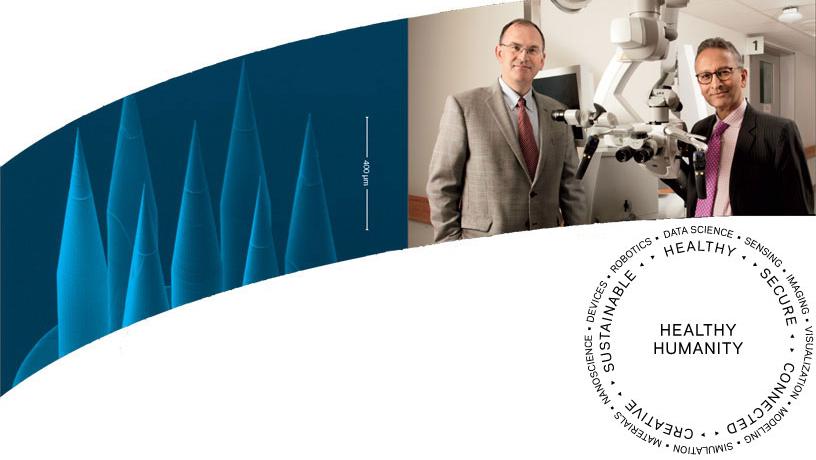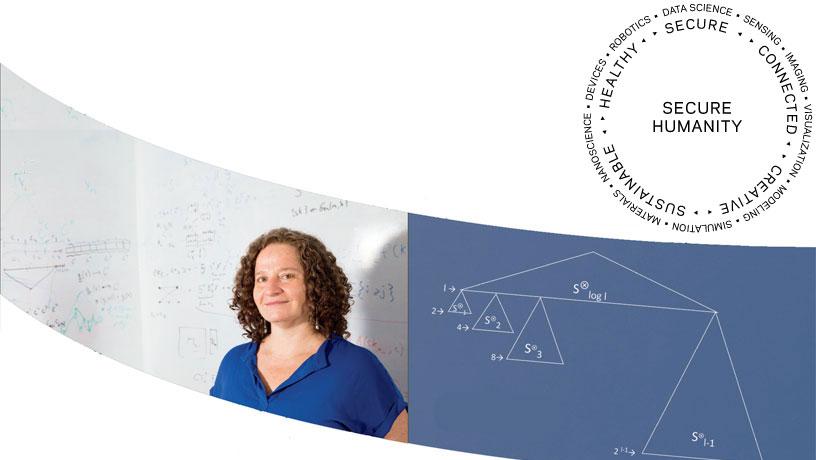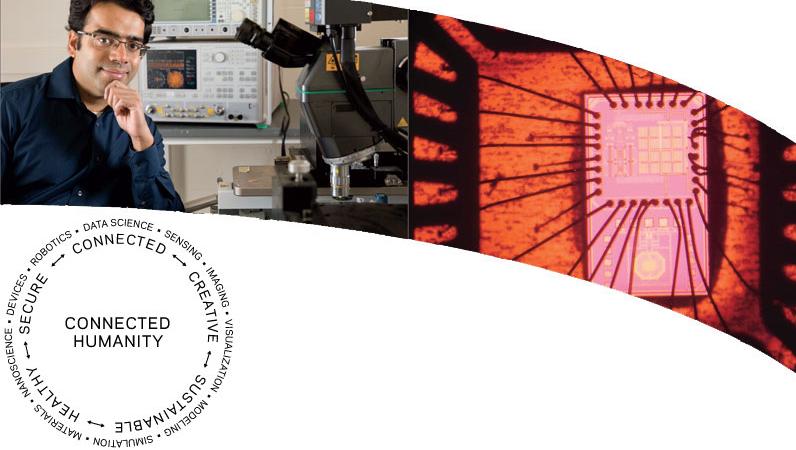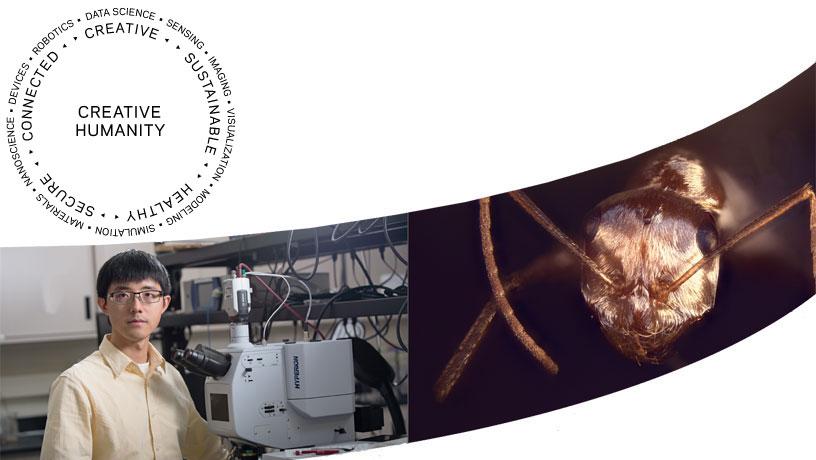Columbia Engineering for Humanity
As technology transforms every area of human endeavor, Columbia Engineering has embraced the unprecedented opportunity to bring creative solutions to the challenges of our time.
From sustainable advances, such as lithium batteries capable of storing clean fuel safely and abundantly to using biomimicry to inspire new products for curbing energy use, we are giving cities and industries the tools to keep the environment healthy. We are pioneering medical devices that could potentially restore hearing to millions, laying the foundation for secure computing, and doubling wireless capacity to driver greater connectivity without increasing bandwidth.
This work embodies our vision for Columbia Engineering; a vision which reflects our aspirations to drive innovative research that makes a positive impact—helping to create a sustainable, healthy, secure, connected, and creative humanity. Our vision, Columbia Engineering for Humanity, is true to our history as a School and is exemplified today by the diverse and pioneering work that our faculty and students are pursuing across departments and disciplines and in partnership with sister schools, institutes, government, and industry.
We have never been more optimistic about the role engineering can play in the service of society and in bringing those advances to populations across the country and around the world.
Read on to see why.

Imagine a world where renewable energy could fuel everything and be stored in abundance.
As humanity seeks more sustainable forms of energy, scientists are looking for ways to store energy and harness the potential of solar and wind power. As an assistant professor in applied physics and applied mathematics at Columbia, Yuan Yang is making progress in the area of advanced batteries with the aim of developing materials to improve their performance and safety.
Lithium batteries hold promise for the ability to power cell phones longer, increase mileage for electric vehicles, and stabilize the output of greener—but less reliable—energy sources like solar and wind power. However, in recent years, the flammability of these batteries has become a notable concern, a problem that is directly related to the liquid electrolyte inside.
Yang, who is also a core faculty member at the Lenfest Center for Sustainable Energy, recently developed a novel ice-templating method for creating all-solid-state batteries that could potentially solve the safety issue hampering this ubiquitous power source. Using the principles of rational design, his team determined an optimized substitute for the liquid and chose a configuration and ratio of ceramic and polymer particles that performed three to four times better than structures in which the particles were randomly dispersed.
“Ceramic has higher ionic activity, but it’s brittle. Polymer is soft and plastic. It’s strong, but ions move slowly inside,” said Yang. “We optimized the geometry of the two in order to get the benefits of both.”
Yang and his team are now using these findings to build better batteries—ones that will be nonflammable and nontoxic, with a longer working life.

Imagine a world where all people could experience sound with perfect clarity.
Professor Jeffrey Kysar leads the Department of Mechanical Engineering at Columbia while maintaining an active research group. In one of their projects, Kysar has been working with Professor Anil K. Lalwani, MD, at the College of Physicians and Surgeons and one of the country’s leading ear surgeons, to develop treatments for various hearing and balance disorders such as age-related and sudden sensorineural hearing loss, as well as Ménière’s disease. These conditions are thought to originate within the inner ear—composed of the cochlea and semicircular canals—a fluid-filled cavity almost entirely surrounded by a hard, protective temporal bone on the side of the skull. Thus the engineering challenge: how to facilitate surgical access to the cochlea without needing to penetrate the temporal bone.
Kysar’s group focused on creating medical portals through an area between the middle ear and cochlea called the Round Window Membrane (RWM), the only place where tissue rather than bone forms the outer cochlear surface. Manipulation of the RWM has not previously been a viable option due to its small size (approximately two millimeters in diameter), its position, and the mechanical properties of the RWM tissue.
Leveraging recent advances in 3D printing technology, Kysar’s group created microneedles that can perforate the RWM to provide direct access to the cochlea. The group is now developing three classes of needles: the first for medication delivery into the cochlea, another for diagnostic purposes, and a third to allow the insertion of cochlear implants through the RWM.
While currently this treatment requires general anesthesia, Kysar envisions a time when his needles could be deployed under local anesthesia during an office visit.
“Such ability to treat hearing and balance disorders through direct diagnosis and treatment of underlying causes within the cochlea has the potential to improve the lives of millions of people,” said Kysar.

Imagine a world where all digital interactions—from banking to voting—were private and secure.
Computer Science is one of the largest departments at Columbia Engineering. No surprise, as it directly relates to some of the biggest issues of our time, from navigating massive sets of data to ensuring personal privacy and security in cyberspace.
As head of the Cryptography Lab, Associate Professor of Computer Science Tal Malkin works to create sound mathematical foundations for security and privacy applications, such as public key encryption, private database search, and secure computation.
Once largely the realm of political intrigue and military applications, today cryptography is essential to banking, voting, communicating, shopping, and much of our online activity. Malkin describes the field today as “rigorous and scientific,” as it sets out to define and prove the exact parameters within which a code is secure. One major goal, she says, is to expand what’s provable as far as possible.
“Can we prove mathematically that no one within these limitations can break the security of the protocol?” asks Malkin. “We want to rely as little as possible on things we cannot prove.”
Secure computation, allowing parties to share information privately while withholding “telling” data, can be useful for finance or health applications. As the growing connectivity of the Internet of Things brings even more vulnerability to these interactions, the need increases for more theoreticians like Malkin to calculate risk.
Malkin is particularly attuned to the need to save and store data without compromising privacy. As chair of the Data Science Institute Cybersecurity Center, she has worked with Columbia Law School on questions concerning cryptography and law enforcement.
“We need a less ad hoc approach on known attacks and a more scientific approach to security that is proof-based,” she says.

Imagine if the world around us could communicate and respond to human action.
The advent of wireless communications has revolutionized how humans connect with each other and access information in unprecedented ways. Mobile phones, which at first linked person to person, now connect us to almost unlimited information. Harish Krishnaswamy, associate professor of electrical engineering, focuses on new devices, circuits, and systems, as well as new wireless applications that push the boundaries of current limits in the field—making connectivity faster, cheaper, and more powerful.
He sees a new “wireless reality” revolution on the horizon— one that gives people access to more information from their real-life surroundings and the ability to interact with their environments in new ways with enhanced perception. Applications for this technology include gesture recognition and driverless cars, as well as virtual and augmented reality.
“Connectivity is almost an outdated concept,” says Krishnaswamy. “The amount of information available online is nothing compared to the amount in the real world. How can wireless enable me to access that info?”
Recently, Krishnaswamy gained media attention for a major breakthrough in wireless technology when he demonstrated full-duplex operation on a chip, an advance that could double data capacity.
He plans to embark on larger-scale, real-world testing of wireless hardware technologies that leverage this critical moment when industries and governments are investing heavily in advances that can increase data flows.
“People have recognized a lot of value in wireless,” said Krishnaswamy. “With its location and the support of the city, Columbia is uniquely positioned to be a major research hub in this space.”

Imagine a world where natural phenomena could be replicated in the built environment to protect and enhance human life.
Assistant Professor of Applied Physics Nanfang Yu brings a physics mindset to biomimicry. While studying physics in college, he maintained a keen interest in biology and what scientists can learn from nature. His interest in the optical properties of living systems led to a connection with biologist Rüdiger Wehner from ETH Zürich, who had been conducting field study of desert ants for decades.
Rüdiger brought to Yu’s attention one particular ant species, the Saharan silver ants, remarkable for their ability to withstand the blazing desert sun that kills many other insects. Intrigued, Yu sought to reveal the cause of their amazing self-cooling ability. His studies found that the silvery hairs covering their body were highly reflective in the solar spectrum, preventing significant absorption of sunlight, and also highly emissive in the thermal radiation spectrum, enabling the ants to dissipate heat via blackbody radiation.
Applying this insight to his interest in devising methods for optimizing energy use, Yu set up a pilot project last fall at the Fort Lee Senior Center to test a cool-roof coating his research team had developed to mimic the optical and thermodynamic properties of the silver ants.
Sensors implanted in the 4,000-square-foot roof indicated a reduction of roof temperature by up to 30oC on the coated roof compared with the uncovered portion. The coating also showed less degradation and loss of solar reflectivity compared with commercial cool-roof coatings. Yu is working with Columbia Technology Ventures to develop and potentially commercialize the product.
“The challenge is to understand the physical mechanism and develop a technically feasible approach to imitate the mechanism,” said Yu. “There are tons of mysteries in life and it is interesting that clever designs could occasionally emerge while one is pondering these mysteries.”
